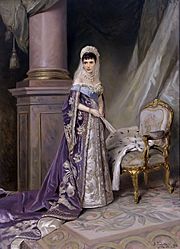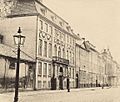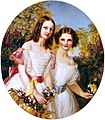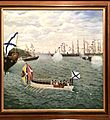Maria Feodorovna (Dagmar of Denmark) facts for kids
Quick facts for kids Dagmar of Denmark |
|
|---|---|
| Empress Consort of Russia | |
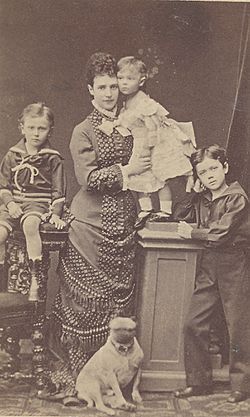
Empress Maria Fyodorovna
|
|
| Spouse | Alexander III |
| Issue | Nicholas II, Alexander Alexandrovich, George Alexandrovich, Xenia Alexandrovna, Michael Alexandrovich, Olga Alexandrovna |
| House | House of Oldenburg |
| Father | Christian IX of Denmark |
| Mother | Louise of Hesse |
Maria Feodorovna, born Princess Dagmar of Denmark (November 26, 1847–October 13, 1928), was an Empress of Russia. She was the wife of Alexander III of Russia. As Empress, she was known as Maria Feodorovna.
She was the second daughter of Christian IX of Denmark and Louise of Hesse. Her son, Nicholas II, was the last Russian Emperor. She lived ten years longer than him.
Contents
Family Life and Royal Connections
Princess Dagmar was officially named Marie Sophie Frederikke Dagmar. She was named after her relative, Queen Dowager Marie Sophie Friederike of Hessen-Kassel. Dagmar's father became the heir to the Danish throne. This was mostly because of his wife's family rights.
Dagmar was born into a princely family that was not very rich. She was baptized into the Lutheran faith. Her father became King of Denmark in 1863. He was known as the "Father-in-law of Europe". This was because his children made many important royal marriages.
Most of her life, she was known as Maria Feodorovna. This was the name she took when she joined the Orthodox Church. This happened just before her marriage in 1866 to the future Tsar Alexander III. Her family called her Minnie.
Maria Feodorovna was the younger sister of Alexandra. Alexandra became Queen Consort of King Edward VII of the United Kingdom. She was also the mother of King George V. This explains why Nicholas II and George V looked so much alike. Maria's brother was King George I of Greece.
Becoming a Russian Empress
Russian leaders wanted the heir to the throne to marry someone from a different country. In 1864, Dagmar became engaged to Grand Duke Nicholas Alexandrovich of Russia. Sadly, he died from tuberculosis on April 22, 1865. His last wish was for Dagmar to marry his younger brother, the future Alexander III.
Dagmar left Copenhagen on September 1, 1866. The famous writer Hans Christian Andersen was there to see her off. He wrote in his diary: "Yesterday, at the quay, while passing me by, she stopped and took me by the hand. My eyes were full of tears. What a poor child! Oh Lord, be kind and merciful to her! They say that there is a brilliant court in St. Petersburg and the tsar's family is nice; still, she heads for an unfamiliar country, where people are different and religion is different and where she will have none of her former acquaintances by her side".
Dagmar received a warm welcome in Kronstadt. Alexander II of Russia and his family greeted her. Her wedding took place on November 9, 1866.
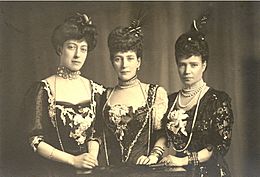
Tsar Alexander III and Maria Feodorovna had four sons and two daughters:
- Tsar Nicholas II (May 6, 1868 - July 17, 1918).
- Grand Duke Alexander Alexandrovich of Russia (June 7, 1869 - May 2, 1870).
- Grand Duke George Alexandrovich of Russia (May 6, 1871 - August 9, 1899).
- Grand Duchess Xenia Alexandrovna of Russia (April 6, 1875 - April 20, 1960).
- Grand Duke Michael Alexandrovich (November 28, 1878 - c. June 12, 1918).
- Grand Duchess Olga Alexandrovna of Russia (June 13, 1882 - November 24, 1960).
Life as Empress
Maria Feodorovna was beautiful and well-liked. She usually did not get involved in politics. Instead, she focused on her family, helping others through charities, and social events. One thing she strongly disliked was Germany. This was because Germany had taken Danish lands.
Maria Feodorovna had a lot of influence within the Romanov family. People praised her for being tactful and good at diplomacy. However, she did not get along well with her daughter-in-law, Alexandra Feodorovna. Maria might have blamed Alexandra for some of the problems her son Nicholas's family faced.
Even after the monarchy was overthrown in 1917, Empress Maria refused to leave Russia at first. It was only in 1919, after her sister Alexandra urged her, that she finally left. She fled from Crimea across the Black Sea to London. King George V sent a warship, HMS Marlborough, to pick up his aunt.
After a short stay in London, she went back to her home country, Denmark. She chose her old holiday home, Hvidøre, near Copenhagen, as her new place to live. Even though Queen Alexandra was always kind to her sister, Maria felt like she was "number two" now.
Maria's later years were sad because many of her close family members died. She refused to believe that her son's family had been killed. She did not allow any memorial services for them at her home. Most of her letters to them are now lost. But in one letter that still exists, she wrote to her son: "You know that my thoughts and prayers never leave you. I think of you day and night and sometimes feel so sick at heart that I believe I cannot bear it any longer. But God is merciful. He will give us strength for this terrible ordeal."
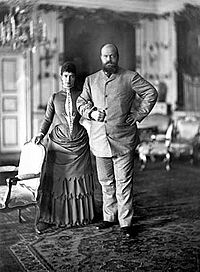
After Her Death
Maria Feodorovna died on October 13, 1928, at Hvidøre near Copenhagen. This was a house she shared with her sister Queen Alexandra. There was a fictional movie called The Mystery of Anna. It showed Anna Anderson on her way to see the Empress. But this is not true, as Anderson was in America when Maria died. Maria Feodorovna never met Anna Anderson, who claimed to be her granddaughter.
Maria has been shown in many films. In the cartoon movie Anastasia, her voice was done by Angela Lansbury. She has also been played by Helen Hayes in a play and a film called Anastasia. Irene Worth played her in the movie Nicholas and Alexandra.
After services in Copenhagen's Russian Orthodox Alexander Nevsky Church, she was buried at Roskilde Cathedral. In 2005, the governments of Denmark and Russia agreed to move her remains. She wished to be buried next to her husband in Russia. Several ceremonies took place from September 23 to September 28, 2006. The funeral service had many important people. The crowd around the coffin was so large that a young Danish diplomat accidentally fell into the grave!
On September 26, a statue of Maria Feodorovna was revealed. It is near her favorite Cottage Palace in Peterhof. After a service at Saint Isaac's Cathedral, she was buried next to Alexander III. This happened in the Peter and Paul Cathedral on September 28, 2006. This was 140 years after she first arrived in Russia. It was almost 78 years after she died.
Images for kids
-
Princess Dagmar's birthplace and childhood home, the Yellow Mansion in Copenhagen.
-
Portrait of a young Princess Dagmar with her dog in the 1860s by Andreas Herman Hunæus.
-
The armoured frigate HDMS Peder Skram which escorted Princess Dagmar to Russia shown here at Kronstadt in September 1866.
-
Maria Feodorovna (left) with her sister Alexandra (center) with their niece Maria of Greece, (right) circa 1893
See also
 In Spanish: María Fiódorovna Románova para niños
In Spanish: María Fiódorovna Románova para niños


